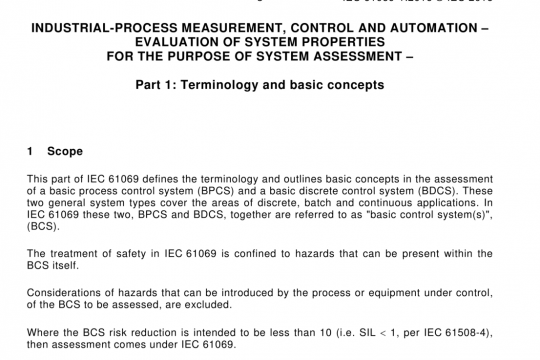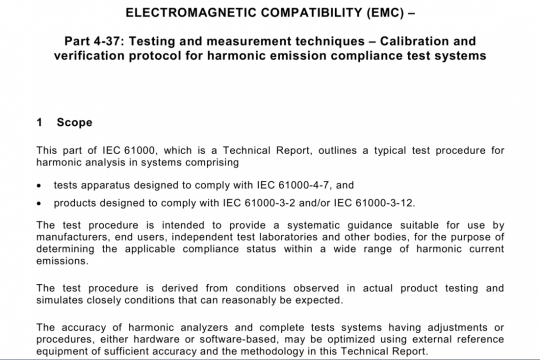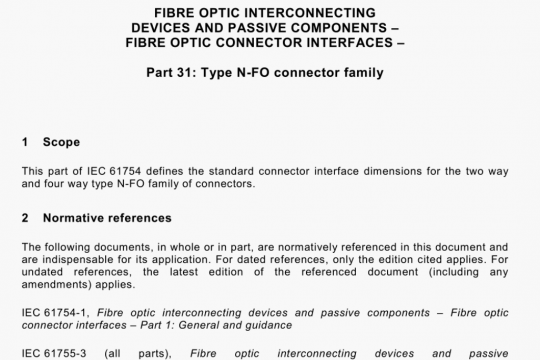IEC 61083-1 pdf free download
IEC 61083-1 pdf free download.Instruments and software used for measurements in high-voltage and high-current tests – Part 1: Requirements for instruments for impulse tests.
6.2.12 Assigned measurement range
The lower limit and upper limit of the assigned measurement range shall be established by proving that the performance of the digitiser meets the requirements of 6.2.3, 6.2.4, 6.2.5, and 6.2.6 when used within the range of the limits.
6.3 Requirements for digital recorders used in reference measuring systems
6.3.1 General requirements
These instruments are used in reference measuring systems specified in IEC 60060-2 for the calibration of approved measuring systems by comparison measurements. The peak and time parameters are in general determined as the mean of at least 10 measurements. The overall uncertainty of a digital recorder used in a reference measuring system according to IEC 60060-2 shall be not more than (at a confidence level of not less than 95 %)
• 0,7 % in the peak voltage (current) measurement of full and standard-chopped (tail chopped) lightning impulses, switching impulses and rectangular impulses;
• 2 % in the peak voltage measurement of front-chopped lightning impulses;
• 2 % for the front time T1 of all relevant types of impulses;
• 1,5 % for the time to half-value T2 of all relevant types of impulses;
• 2 % for the time to chopping T of the standard chopped (tail chopped) lightning voltage impulse;
• 4 % for the time to chopping T of the front chopped lightning voltage impulse;
• 2 % for the peak time T of switching voltage impulse;
• 2 % for Td and T for the rectangular current impulse.
6.3.2 Sampling rate
The sampling rate shall be not less than 60/Tn where T is the time interval to be measured.
6.3.3 Rated resolution
A rated resolution of 9-bit (with peak amplitude at least 20 % of the full-scale deflection) or better is required for tests where the impulse parameters are to be evaluated.
6.3.4 Error of time base
The maximum value of the time base errors as measured in 5.5 shall be less than 0,1 %. The maximum relative standard deviation of measured mean period values shall be less than 10 %.
6.3.5 Rise time
The rise time shall not be more than 2 % of T where T is the time interval to be measured.
6.4.5 Performance checks
Performance checks on the instrument are required only if performance checks on the complete measuring system indicate that the assigned impulse scale factor has changed significantly.
Performance checks shall be made for each setting of the instrument that is to be used in the impulse tests. This check shall include the possible external attenuator, if it was not calibrated with divider or shunt.
7 Requirements for peak voltmeters
The overall expanded uncertainty of a peak meter used in an approved measuring system
according to IEC 60060-2 shall be not more than (at a level of confidence of not less than 95 %,
see Annex A and Annex B of IEC 60060-2:2010)
• 2 % in the extreme value measurement of full and standard-chopped (tail chopped) lightning voltage impulses;
• 2 % in the peak value of switching voltage impulses, exponential current impulses and rectangular current impulse.
NOTE Peak voltmeters measures the extreme value (LJe)i and they do not meet the requirements for measuring the test voltage (U1) of standard lightning impulses, the peak voltage of front chopped lightning impulses or time parameters.
8 Uncertainty contributions for complete measuring systems
The uncertainty values determined in the tests specified in this document serve two purposes. The primary purpose is to set the measurement uncertainty limits for the approved digital recorder. The second purpose is to enable the estimation of measurement uncertainties of a complete measuring system as specified in other related international standards, such as IEC 60060-2 and IEC 62475, with the uncertainty values of the digital recorder as necessary contribution components.
Inclusion of uncertainties of an approved impulse digitiser as components in the combined uncertainties of a complete measuring system shall follow the procedure as specified in the relevant standard for the complete measuring system such as lEG 60060-2 and IEC 62475.IEC 61083-1 pdf download.




